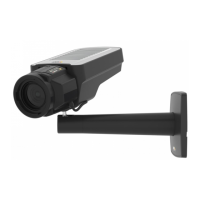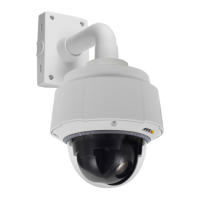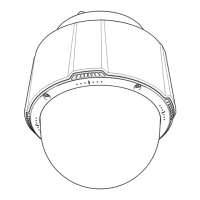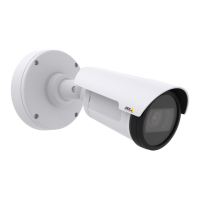AXIS Q1615-E Mk II Network Camera
Video and Audio
• External Microphone: Select this audio source to use the external microphone.
• Line: Select this audio source to use a Line in device, that is, an audio mixer for multiple microphones or a microphone
with a built-in amplier.
Select the +30 dB microphone boost option to amplify the signal of the external microphone connected to the Axis product.
This option is not available when the Line source is selected.
The Microphone power option provides DC power for an external microphone. Microphone power should only be used with
microphones that require this kind of powering, that is, electret microphones. This setting should not be enabled when using a dynamic
or battery powered microphone. For use of a professional microphone requiring 12 V phantom power, there is a built-in power supply.
Note
To use a professional microphone requiring 48 V phantom power, you need an external power supply and a balanced
converter (audio transformer) in between. The input must never exceed 12 V DC.
Use the Input gain to control the volume (dB Full Scale) of the audio input. If the sound is too low, choose a higher dB, to amplify
the sound. If the sound is too high, choose a lower dB. The Level bar gives a visual representation of the audio signal level in dB
relative to the full-scale input level.
• Green — the signal is at a good level.
• Yellow — the signal is becoming distorted.
• Red — the signal is distorted.
Use the Encoding option to select digital audio encoding format.
• AAC requires a license for both encoding and decoding. AAC is the least complicated and most widely used codec. If
achieving the best possible audio quality is a priority, AAC is the recommended codec to use. An AAC license is included
in the Axis product.
• G711 is an unlicensed standard codec that is useful when integrating audio into a VoIP system
• G726 is an unlicensed speech codec that is most commonly used within the security industry.
• Opus is an unlicensed codec that is used for interactive real-time audio transmission over network.
Note
If recording audio to edge storage, such as an SD card or network share, use AAC encoding.
The Sample rate denes the number of times per second the sound is sampled. A higher sample rate will provide better audio
quality, but also requires a greater bandwidth.
Set the required Bit rate depending on the selected encoding. A higher bit rate will give better audio quality. A lower bit rate
may have latency or delay, but will require less bandwidth.
For more information about these settings, please see the online help
.
Audio Output
An external speaker can be connected to the Audio-out connector (an active speaker with built-in amplier is required for this). The
output can be connected to another amplier with speakers. A stereo connector must be used for the audio out.
Congure the audio output settings under Video & Audio > Audio Settings.
Output gain - Control the volume of the line audio output. If the sound is too low, choose a higher dB value. If the sound is
too high, choose a lower dB value.
32

